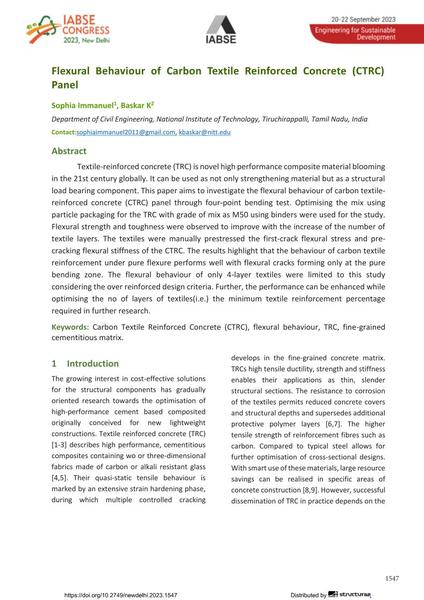Flexural Behaviour of Carbon Textile Reinforced Concrete (CTRC) Panel

|
|
|||||||||||
Détails bibliographiques
| Auteur(s): |
Sophia Immanuel
K. Baskar (Department of Civil Engineering, National Institute of Technology, Tiruchirappalli, Tamil Nadu, India) |
||||
|---|---|---|---|---|---|
| Médium: | papier de conférence | ||||
| Langue(s): | anglais | ||||
| Conférence: | IABSE Congress: Engineering for Sustainable Development, New Delhi, India, 20-22 September 2023 | ||||
| Publié dans: | IABSE Congress New Delhi 2023 | ||||
|
|||||
| Page(s): | 1547-1553 | ||||
| Nombre total de pages (du PDF): | 7 | ||||
| DOI: | 10.2749/newdelhi.2023.1547 | ||||
| Abstrait: |
Textile-reinforced concrete (TRC) is novel high performance composite material blooming in the 21st century globally. It can be used as not only strengthening material but as a structural load bearing component. This paper aims to investigate the flexural behaviour of carbon textile- reinforced concrete (CTRC) panel through four-point bending test. Optimising the mix using particle packaging for the TRC with grade of mix as M50 using binders were used for the study. Flexural strength and toughness were observed to improve with the increase of the number of textile layers. The textiles were manually prestressed the first-crack flexural stress and pre- cracking flexural stiffness of the CTRC. The results highlight that the behaviour of carbon textile reinforcement under pure flexure performs well with flexural cracks forming only at the pure bending zone. The flexural behaviour of only 4-layer textiles were limited to this study considering the over reinforced design criteria. Further, the performance can be enhanced while optimising the no of layers of textiles(i.e.) the minimum textile reinforcement percentage required in further research. |
||||
